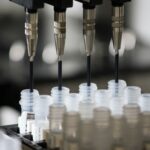
The main strategy to control the COVID-19 pandemic depends on testing to mitigate the risk of population transmission through infection prevention measures. Current testing methods are the rate limiting factors in terms of the number of persons that can be tested and the turnaround time for results. Swabs from the upper respiratory tract can provide false-negative results and cause discomfort during the sample collection process which may discourage people from re-testing in the future. High SARS-CoV-2 RNA has been detected in the oropharynx, therefore this review aimed to assess the use of saliva for the diagnosis and monitoring of patients with COVID-19.
Methods
The Preferred Reporting Items for Systematic Review and Meta-Analyses were used to inform the methodology of this review. PubMed, Embase, LILACS, Scopus and Web of Science were the databases searched. Additionally the grey literature was searched and hand searches of the reference lists were conducted. Studies were included if they assessed the potential diagnostic value or other discriminatory properties of biological markers in the saliva of patients with COVID-19.
Results
- 495 articles were retrieved across the initial database search. Following removal of duplicates and implementation of the inclusion and exclusion criteria, 28 studies were included in the review.
- The studies were published in China, Korea, Italy, Japan, Australia, Canada, Thailand, United Kingdom, United States and Vietnam. The majority of studies evaluated COVID-19 markers in adults and 3 studies evaluated these in neonates and paediatric patients. A total of 2,095 patients were pooled in this review.
- The most commonly used SARS-CoV-2 detection test in saliva samples was the reverse transcription quantitative polymerase chain reaction (RT-qPCR).
- Regarding the sampling method, drooled saliva, coughed-out saliva, oral swab, glandular secretion, posterior oropharyngeal saliva and throat saliva were used.
- 28 studies detected the presence of SARS-CoV-2 RNA in saliva. The reported viral load ranged from 9.9 x 102 to 1.2 x 108 copies/ml.
- 9 studies reported the sensitivity and/or specificity of RT-qPCR analysed saliva specimens as compared with the gold standard diagnosis of throat and nasopharyngeal swabs. This varied from 66-91.7% and from 97-100% respectively.
- The cost savings were analysed by one study and reported the cost of equipment as US $8.24 per 100 saliva specimens compared with US $104.87 per 100 for nasopharyngeal swabs.
- The implication of daily schedules on saliva collection were reported in 2 studies. Differences during the day were identified, as were higher viral loads early in the morning versus bedtime. Additionally, saliva specimens collected during the day had a lower rate of positive concordance with nasopharyngeal swab viral load than saliva collected early in the morning.
Conclusions
The authors concluded: –
A reliable detection of SARS-CoV-2 in the saliva of patients with COVID-19 has been confirmed, with diagnostic performance comparable to the current standards (nasopharyngeal and throat swabs).
Comments
This review identified a range of sensitivity and specificity for COVID-19 detection in saliva which overlaps with the gold standard of nasopharyngeal swabs nonetheless, has a larger diagnostic efficacy range. Therefore, at present, more research is required to optimise COVID-19 detection in salvia to reduce this range. The major cost saving and non-invasive sample collection method provides support for this diagnostic utility. In addition, it is important to contextualise this approach with its principle methodology of PCR, a sensitive test that will detect SARS-CoV-2 virus gene fragments which at present is the operational gold standard for detecting COVID-19 disease in clinical practice. However, PCR does not determine if the detected fragment is ‘live’ (the ability to reproduce and infect others). Viral culture is required to determine if the virus is truly active (infectious) however studies to date have not been able to make an association between RT-PCR results and success of viral culture. Prolonged viral RNA shedding has been known to last for weeks after recovery and low levels of viral RNA detection has no correlation on infectivity unless confirmed with laboratory viral culture. These limitations need consideration when proposing a new COVID-19 diagnosis method.
Links
Primary paper
Fernandes LL, Pacheco VB, Borges L, et al. Saliva in the Diagnosis of COVID-19: A Review and New Research Directions. Journal of Dental Research. 2020. doi:10.1177/0022034520960070
Other references
The Centre for Evidence-Based Medicine. PCR positives: what do they mean? September 2020
Surkova E, Nikolayevskyy V, Drobniewski F. False-positive COVID-19 results: hidden problems and costs. Lancet Respir Med. 2020. doi: 10.1016/S2213-2600(20)30453-7.
Dental Elf – 12th May 2020
Photo Credits
Photo by National Cancer Institute on Unsplash

Testing the body properly for any disease is a must. In this pandemic, saliva has become the main suspect for testing of covid. Also, in healthcare departments like dentistry, saliva can cause many issues regarding infection. Thanks for sharing this post here! Surely, this will be helpful.
Thank you for considering our research.